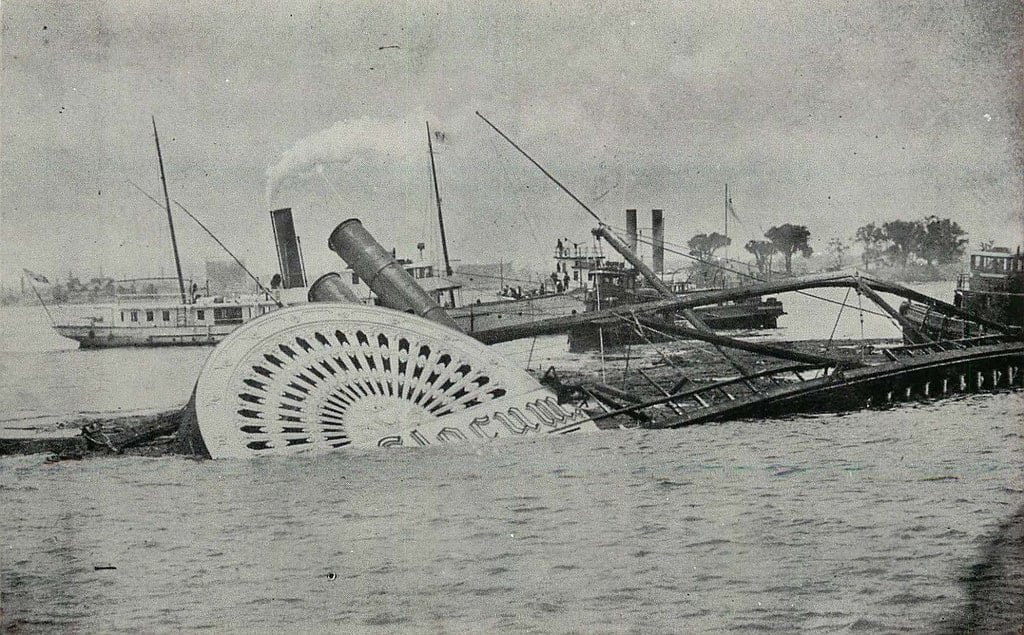The tragedy on September 11, 2001, devastated several Americans across the country and even the world. Numerous people have lost their lives in this disaster. But did you know that it wasn’t the first significant disaster they encountered?
The burning and sinking of steamboat General Slocum in 1904 were considered the worst disaster in New York before 9/11. Nine hundred fifty-five passengers died, and it was reported that life jackets on board had iron weights instead of corks.
The PS General Slocum
The PS General Slocum was a sidewheel passenger steamboat built in Brooklyn, New York, in 1891. The massive boat was powered by a single-cylinder, surface-condensing vertical-beam steam engine built by W. & A. Fletcher Company of Hoboken, New Jersey.
Onboard were two boilers that supplied the steam to operate the massive sidewheels. Each sidewheel had a 31-foot diameter and had 26 paddles, allowing her to reach a top speed of 16 knots.
The boat was built with white oak and yellow pine. It was 250 feet long and had three decks, the main, promenade, and hurricane. It had three watertight compartments and 250 electric lights. The boat had a legal capacity of 2,500 passengers.
The boat was named after civil war general and New York Congressman Henry Warner Slocum. It was owned by the Knickerbocker Steamboat Company and operated in the New York City area as an excursion steamer for thirteen years. (Source: Owlapps)
Incidents of the Doomed Boat
The PS General Slocum experienced several accidents before the deadly 1904 tragedy. Four months after her maiden voyage, the boat ran aground in Rockaway, where tug boats were needed to pull her free.
In 1984, the boat struck a sandbar headed home from Rockaway with 4,700 passengers. The Slocum hit the sandbar with enough force to severely affect its electrical generator. It again ran aground in Coney Island during a storm the following month. Its passengers had to be transferred to a different ship.
In the same year, General Slocum collided with the tugboat R. T. Sayre in the East River, sustaining substantial damage to its steering. In 1898, it suffered another collision with Amelia near Battery Park.
In 1901, General Slocum was boarded by some 900 drunk anarchists. The passengers then started a riot on board and attempted to hijack the ship. The crew fought back, and the captain docked Slocum to a police pier.
In 1902, the ship ran aground once more, causing 400 passengers to be stranded overnight. (Source: Owlapps)
The Disaster of 1904
On June 15, 1904, General Slocum was chartered by St. Mark’s Evangelical Lutheran Church from the Little Germany district of Manhattan. It was an annual trip made by the group, having taken the trip for 17 consecutive years.
The ship was to sail up the East River then proceed eastward across Long Island to Locust Grove, a picnic site in Eatons Neck. It was known that there were about 1,358 passengers and 30 crew members aboard on this trip.
The disaster started when a fire started in the forward cabin, known as the Lamp Room, presumably caused by a discarded cigarette. Staw, oily rags fueled the fire, and lamp oil was found in the room. In a few minutes, fires started on different parts of the boat. When the captain discovered the fire, he ordered the pilot to beach the ship on North Brother Island at full speed.
The disaster claimed around 955 lives, and it could have been prevented if the ship’s owners had made efforts to maintain its safety equipment. It was known that the water hose that was to be used as a firefighting tool was made of cheap unlined linen, and its coupling was stuck on the standpipe, the pipe that will supply water for the hose.
When the crew members couldn’t attach a rubber hose to the linen hose, they gave up on trying to extinguish the fire since no water was made available. There were also reports that the crew had never done a fire drill that year and that the lifeboats were tied up and inaccessible.
Other reports claim that the life jackets didn’t help the passengers float but instead made them sink. Upon investigation, the supplier of cork materials for the life jackets placed 8 oz iron bars inside the cork to meet minimum cork requirements. (Source: Owlapps)
